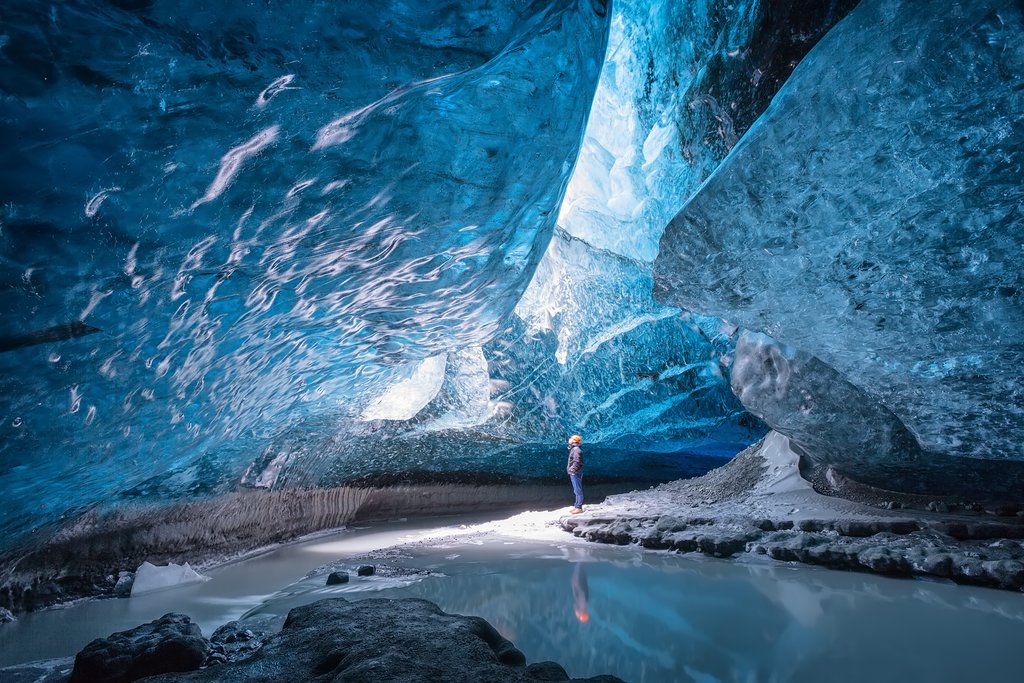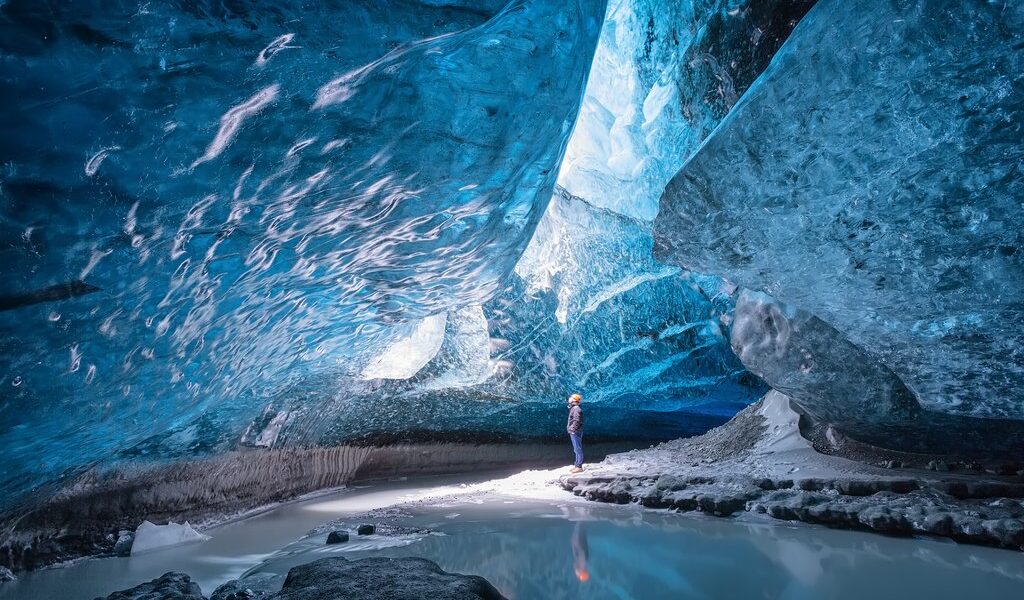
Take advantage of the snowy season where everything seems more calm and quiet, and when the tourist crowds are at their smallest. This is also one of the best times for viewing the Northern Lights. Read on to learn more about visiting Iceland in January.
Iceland in January: A Winter Wonderland Awaits
Iceland in January presents a unique travel experience, offering a serene escape into a winter wonderland. While many envision Iceland as perpetually frigid, the reality is more nuanced.
Weather in Iceland in January
The Icelandic winter, contrary to popular belief, is not characterized by extreme sub-zero temperatures. In fact, average low temperatures hover just below freezing, typically ranging from 27 to 35 degrees Fahrenheit. However, it’s crucial to acknowledge the significant impact of wind chill. The powerful Icelandic winds can dramatically lower the perceived temperature, making it feel considerably colder than the actual reading.
For those venturing to Northern Iceland or higher altitudes, snowfall is common during January. Conversely, other regions of the island are more prone to rainfall. Therefore, dressing strategically in layers is paramount. A high-quality, windproof and waterproof jacket is essential, complemented by a warm hat and thermal layers to ensure comfort and protection from the elements.
If you plan on embarking on a self-drive tour to immerse yourself in the breathtaking Icelandic landscapes, diligent monitoring of road conditions is absolutely crucial before setting off. The Icelandic weather is notorious for its sudden and unpredictable shifts. Exercise extreme caution while driving, as roads that appear to be in good condition can be deceptively slippery due to ice patches or hidden frost.
Daylight hours are limited in January due to Iceland’s high northern latitude. The precise amount of daylight varies depending on your specific location within the country. Certain areas may experience as little as two hours of daylight, while other towns find themselves shrouded in near-total darkness as the sun remains obscured by the imposing mountains. Reykjavík, the capital city, enjoys a slightly more generous amount of daylight, with approximately four to six hours, gradually extending to nearly seven hours by the end of the month.
Crowds and Costs in Iceland in January
For travelers seeking tranquility and a more intimate experience, January is an ideal time to visit Iceland. The post-Christmas period, after January 6th, witnesses a significant decrease in tourist crowds. Hotels offer a haven of warmth and ambiance, adorned with candles, crackling fireplaces, and twinkling lights.
January falls within Iceland’s off-season, resulting in lower prices for flights, accommodations, and car rentals. The reduced number of daylight hours contributes to this slower travel period. Capitalizing on these cost savings allows you to extend your stay or indulge in additional experiences.
Where to Go in Iceland in January
The absence of large crowds and the unique quality of the winter light transform Iceland’s popular destinations into even more captivating experiences in January.
Reykjavík, the vibrant capital, serves as an excellent starting point for your Icelandic adventure. Despite its relatively small size, Reykjavík boasts a remarkable array of attractions, including cutting-edge architecture, stylish boutiques, trendy restaurants, and a rich tapestry of Viking history. Moreover, Reykjavík provides convenient access to the stunning, otherworldly landscapes that define Iceland’s allure.
Akureyri, the capital of Northern Iceland, is another city that merits a visit. Known for its lively atmosphere throughout the year, Akureyri serves as a gateway to some of the country’s finest ski resorts. From Akureyri, you can venture to Lake Mývatn, a region that offers a captivating glimpse into Iceland’s volcanic and geothermal wonders, with hot springs, intriguing caves, and vast lava fields.
Iceland’s iconic Golden Circle and the dramatic South Shore offer equally stunning vistas with the added advantage of being relatively crowd-free during January. The Golden Circle encompasses the Þingvellir National Park, a UNESCO World Heritage site of immense historical and geological significance; the Geysir Geothermal Area, where Strokkur erupts with impressive regularity; and the majestic Gullfoss waterfall. Journeying further south along the coast will lead you through picturesque farmland, past active volcanoes, and towards the awe-inspiring Eyjafjallajokull glacier. You’ll also encounter the captivating Seljalandsfoss and Skogafoss waterfalls, and the black sand Reynisfjara beach, located just outside the charming village of Vík.
What to Do in Iceland in January
Despite the limited daylight hours, Iceland offers a plethora of activities and attractions to fill your days in January, provided you maximize your time during the available daylight.
Equip yourself with crampons, grab your camera, and embark on a thrilling hike across Vatnajökull, Europe’s largest ice cap. Alternatively, explore Mýrdalsjökull, home to an enchanting ice cave beneath a volcano, renowned for its mesmerizing translucent blue hues. For a truly unique perspective, experience the Icelandic landscape from the saddle of a native Icelandic horse. These sturdy and fluffy creatures provide a comfortable and memorable way to traverse the wintery terrain.
For the adventurous at heart, don a drysuit and plunge into the glacial waters of the Silfra fissure in Þingvellir National Park. Snorkeling or scuba diving in this crystal-clear fissure offers the unparalleled experience of swimming between the North American and Eurasian tectonic plates.
A range of traditional winter activities is also readily available, including snowmobiling and dog sledding across snowfields and atop glaciers, as well as downhill and cross-country skiing, and snowshoeing. For the best skiing opportunities in Iceland, head north to the resorts in and around Akureyri.
As darkness descends, embark on a Northern Lights tour to witness the ethereal Aurora Borealis. Escape the city lights and venture into the tranquil countryside in search of this mesmerizing natural phenomenon. The specific destination will depend on the weather forecast and cloud cover, but potential locations include Þingvellir National Park at Lake Þingvallavatn, the otherworldly lava fields of the Reykjanes Peninsula, or the scenic Borgarfjörður area.
A camera and tripod are essential for capturing the magic of the Northern Lights.
Events in Iceland in January
January in Iceland is not just about landscapes; it’s also a time for unique cultural experiences.
New Year’s Eve: Icelanders celebrate New Year’s Eve with unparalleled enthusiasm. With no restrictions on the quantity or timing of fireworks, expect a lively and exuberant celebration, reaching its peak around midnight and continuing into the early hours.
Þrettándinn: On January 6th, the thirteenth day of Christmas, Icelanders bid farewell to the festive season with bonfires, fireworks, and traditional songs performed in public squares. Children participate by sculpting mythical Icelandic creatures from snow and ice.
Þorrablót: This ancient mid-winter festival, dating back millennia, brings communities and visitors together to celebrate the “feast of Þorri” (derived from the old Norse calendar). Þorri commences around January 20th with Bóndadagur (Husbands’ Day) and concludes around February 20th with Konudagur (Women’s Day), Iceland’s equivalent of Valentine’s Day. The festival features traditional foods such as pickled rams’ testicles, Hakarl (putrefied shark), and boiled sheep’s head, often shared around communal bonfires accompanied by traditional Icelandic songs.
Sóldagur (Sun Day): Celebrated in the Westfjords, where sunlight is scarce during winter, Sóldagur marks the first day the sun shines (even briefly) on Sólgata (Sun Street). Residents gather on the street to bask in the fleeting rays and then prepare and enjoy “Sun Pancakes,” served with cream and rhubarb jam.
Dark Music Days: This annual festival of contemporary and new music unfolds at the Harpa concert hall in downtown Reykjavík during the darkest period of winter, spanning the end of January and the beginning of February.
Exploring Iceland in January: Recommended Itineraries
These itineraries offer a glimpse into the diverse experiences that await you in Iceland in January:
Chasing the Northern Lights in South Iceland – 4 Days: Fulfill your dream of witnessing the spectacular Northern Lights with this concise trip to southern Iceland. Complementing nighttime Aurora Borealis expeditions, you’ll explore some of the country’s most dramatic natural wonders and unforgettable landscapes, including impressive waterfalls, vast glaciers, and volcanic beaches.
Winter Self-Drive in the West, Golden Circle & South Coast: 5 Days: This scenic self-drive tour is designed for nature enthusiasts and adventure seekers. Discover the iconic Golden Circle, explore vibrant Reykjavik, and venture off the beaten path with tours of ice caves and craters, snorkel trips between tectonic plates, and walks behind ice-covered waterfalls.
B-1128

